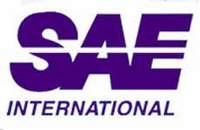2009 SAE International Congress
 2009 SAE WORLD CONGRESS |
2009 SAE WORLD CONGRESS IN DETROIT
One Measure of the Automobile
Industry
By Steve Purdy
TheAutoChannel.com
Detroit Bureau
There was a time, not many years ago, that the SAE show, held every spring in the Motor City, was a huge, lively, splashy event. Not anymore. Now it’s almost painfully subdued. No more big, expensive displays or lavish presentations and demonstrations to catch our attention. No more spiffy gifts or food to attract visitors to a booth or display. It’s now purely business.
I’m not sure that’s necessarily a bad thing. Much of the bluster was wasted effort and money anyway. I suppose. As a practical matter, there is no money or effort to waste anymore. Like everything else in this dismal economy the emphasis is on efficiency.
Many of the larger, more impressive displays were companies I’ve not heard of. Even though the supplier industry is not really my beat I used to know most of the major ones. But, there has been so much transition and so many innovations in recent years that new names are displacing old ones at an amazing rate.
There is no shortage of innovation in spite of the condition of the auto business. The enthusiasm of the innovators is striking as well. There seems to be a sense out there that opportunity and vibrancy have not been quelled by the industry’s woes.
Would you believe that one of the eye-catching displays on the floor is a raucous red Hummer H3, tilted up on its side to reveal alteration in its underbelly, that is good for 100-mpg? Well, that’s what’s plastered across its rear window, at least. I talked to the President of Raser Technologies from Salt Lake City, David West, who explained that the Hummer is powered by a system very similar to GM’s new Volt – that is, an “extended range” or “plug-in” gasoline/electric hybrid power unit. Like the Volt if you drive less than 40 miles a day then have the opportunity to charge it up you’ll never use any gasoline. Your gas mileage would be, in effect, infinite. If you drive more than that you’ll access the small (2-liter) Ecotec engine that powers a generator (not the vehicle) to keep power in the battery so that you can drive as far as you like. No worries about running out of electrons.
That 100-mpg claim is based on driving about 50 miles a day getting into the auxiliary power system just a little bit. If you are driving across the country, having spent all your electrons in the first 40 miles, running the engine/generator steadily, you can expect about 33-mpg, Mr. West tells me. Still not bad for an H3, wouldn’t you say?
Like Volt, this is not a speculative, pie-in-the-sky prospect. Both vehicles are in final stages of being prepared for sale to the public. The Rasor folks are in discussions with Washington officials to produce a thousand copies of the H3 for government fleet use.
Downstairs in Cobo’s Michigan Hall a half dozen green cars were available for short drives around the city – a luxurious BMW 535d (a diesel that gets 46.1-mpg on the highway), Jetta TDI, Ford’s new Fusion Hybrid, Toyota’s next generation Prius (coming to dealers just about now), a sexy little electric roadster called Dodge Circuit EV (that looks just like a Lotus Elite), and a few others.
I first hopped into the flashy, bright-yellow Saturn Sky Redline. What’s green about this little performance sports car? Well, the Bosch folks who presented it were touting their contributions to the direct injected, turbocharged, 2.0-liter engine that pumps out a good 260 horsepower to motivate this tiny car. Fuel economy of 21/30 city/highway is better than the normally-aspirated 2.4-liter engine in the standard, tepid-performing Sky. Direct injection and turbocharging is becoming a dominate technology boosting power and improving fuel efficiency at the same time. Ford is making hay with that technology with their Ecoboost family of engines; a four banger with V6 power and a V6 with V8 power.
I also had a revealing drive in GM’s advanced hydrogen fuel cell Equinox, a small CUV with mild manners featuring what may be the powertrain that saves the world. Many future thinkers in the car business believe that fuel cells will be the end game in how we power our vehicles in the future. A few of these Equinox will be in the hands of test fleets and the concept looks promising. The issue, of course, is the nearly complete lack of hydrogen infrastructure.
Another interesting project we encountered here at SAE is the ongoing development of a split-cycle engine by a company called Scuderi. Split-cycles are not new but this company has brought it further than anyone else just since 2002. This unusual configuration uses two cylinders instead of one to accomplish the four-cycle, internal combustion process. Somehow, they get as much or more power out of that little engine than is common from much larger 4-cylinder engines. It seems a bit gimmicky to me but our colleague, Thom Cannnel (whose by line you see here often), knows much more about deep technology than I and he is impressed. The Scudari folks hint about a couple of deals they have in Europe that my result is seeing these engines in production cars sooner than anyone would imagine.
As a measure of the automobile industry we’d have to say that this year’s SAE World Congress was telling. What it is telling us is that while the industry, like the economy as a whole, is in an unprecedented slump, there is hope on the horizon. We know not where this wild ride will bottom out, but we can see clearly there is no let up in the advancement of the technology that makes up our automobiles, trucks and other things vehicular.
© Steve Purdy, Shunpiker Productions, All Rights Reserved


